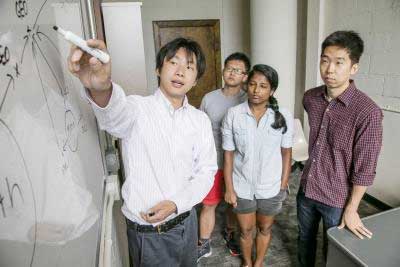| Apr 19, 2018 |
New research seeks to optimize space travel efficiency
|
|
(Nanowerk News) Sending a human into space and doing it efficiently presents a galaxy of challenges. Koki Ho, University of Illinois assistant professor in the Department of Aerospace Engineering, and his graduate students, Hao Chen and Bindu Jagannatha, explored ways to integrate the logistics of space travel by looking at a campaign of lunar missions, spacecraft design, and creating a framework to optimize fuel and other resources (Journal of Spacecraft and Rockets, "Optimization of In-Space Supply Chain Design Using High-Thrust and Low-Thrust Propulsion Technologies" and "Integrated Space Logistics Mission Planning and Spacecraft Design with Mixed-Integer Nonlinear Programming").
|
 |
| Koki Ho at white board with students. (Image: University of Illinois)
|
|
Ho said it's about finding a balance between time and the amount of fuel - getting there fast requires more fuel. If time isn't an issue, slow but efficient low-thrust propulsion might be a better choice. Taking advantage of this classical tradeoff, Ho noted that there are opportunities to minimize the launch mass and cost when looking at the problems from a campaign perspective--multiple launches/flights.
|
|
"Our goal is to make space travel efficient," Ho said. "One way to do that is to consider campaign designs, that is, multiple missions together--not just launching everything from the ground for every mission like Apollo did. In a multi-mission campaign, previous missions are leveraged for subsequent missions. So if a previous mission deployed some infrastructure, such as a propellant depot, or if work had begun to mine oxygen from soil on the moon, those are used in the design of the next mission."
|
|
Ho used data from previously flown or planned missions to create simulated models of a combined campaign. The model can be modified to include heavier or lighter spacecraft, a specified set of destinations, the precise number of humans on board, etc., to validate his predictions about the efficiency.
|
|
"There are issues with the vehicle sizing," Ho said. "In our previous studies, in order to make the problem efficiently solvable, we had to use a simplified model for the vehicle and infrastructure sizing. So creating the model was fast, but the validity of the model wasn't as good as we desired."
|
|
In one of the current studies, Ho and his colleagues addressed the fidelity issue in these previous simplified models by creating a new method to consider more realistic mission and vehicle design models while maintaining the mission planning computational load at a reasonable level.
|
|
"In this research we are designing the vehicles from scratch so that the vehicle design can become part of the campaign design," Ho said. "For example, if we know we want to send a human into space Mars by the 2030s, we can design the vehicle and plan the multi-mission campaign to achieve the maximum efficiency and the minimum launch cost over the given time horizon."
|
|
Ho's research also incorporates the concept of propellant depots in space, like strategically located truck stops on a turnpike. He said it is an idea that has been tossed around for a while among scientists. "There are questions about how efficient the depots actually are," Ho said. "For example, if it takes the same or more amount of propellant just to deliver the depot then what's the point of sending it ahead?"
|
|
Ho's studies provide one solution to this question by leveraging a combination of high-thrust and low-thrust propulsion system.
|
|
"A preparatory mission might be conducted beforehand to deliver into orbit mini-space stations that store fuel, cargo, or other supplies," Ho said. "These craft can be pre-deployed so they are orbiting and available to a manned spacecraft that is deployed later. The cargo/fuel space craft can make use of low-thrust technologies because the time it takes to get to its destination isn't critical. Then for the manned spacecraft, we'd use high-thrust rockets because time is of the essence when putting humans in space. This also means that because the fuel is already at these space stations, the actual manned ship doesn't have to carry as much fuel."
|

